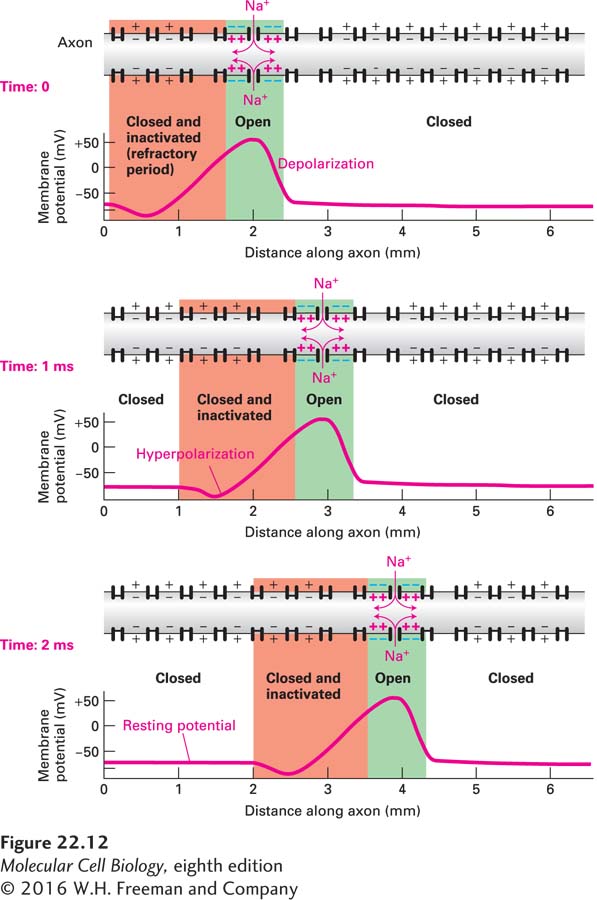Action Potentials Are Propagated Unidirectionally Without Diminution
An action potential begins with changes that occur in a small patch of the axonal plasma membrane near the cell body. At the peak of the action potential, passive spread of the membrane depolarization is sufficient to depolarize a neighboring segment of membrane. This causes a few voltage-gated Na+ channels in this region to open, thereby increasing the extent of depolarization in the region and causing an explosive opening of more Na+ channels and generation of an action potential. This depolarization soon triggers opening of voltage-gated K+ channels and restoration of the resting potential. The action potential thus spreads as a traveling wave away from its initial site without diminution.
As noted earlier, during the refractory period voltage-gated Na+ channels are inactivated for several milliseconds. Such refractory channels cannot conduct ion movements and cannot open during this period even if the membrane is depolarized owing to passive spread. As illustrated in Figure 22-12, the inability of Na+ channels to reopen during the refractory period ensures that action potentials are propagated only in one direction, from the initial axon segment where they originate to the axon termini. Because the Na+ channels upstream of the location of the action potential are still inactivated they cannot be reopened by the small depolarization caused by passive spread. In contrast, the Na+ channels “downstream” of the action potential begin to open.

FIGURE 22-12 Unidirectional conduction of an action potential due to transient inactivation of voltage-gated Na+ channels. At time 0, an action potential (pink line) is at the 2-mm position on the axon; the Na+ channels at this position are open (green shading), and Na+ ions are flowing inward. The excess Na+ ions diffuse in both directions along the inside of the membrane, passively spreading the depolarization in both directions (curved pink arrows). But because the Na+ channels at the 1-mm position are still inactivated (red shading), they cannot yet be reopened by the small depolarization caused by passive spread; the Na+ channels at the “downstream” 3-mm position, in contrast, begin to open. Each region of the membrane is refractory (inactive) for a few milliseconds after an action potential has passed. Thus the depolarization at the 2-mm site at time 0 triggers action potentials downstream only; at 1 ms an action potential is passing the 3-mm position, and at 2 ms an action potential is passing the 4-mm position.
The refractory period of the Na+ channels also limits the number of action potentials that a neuron can conduct per second. This is important, since it is the frequency of action potentials that carries the information. Reopening of Na+ channels upstream of an action potential (i.e., closer to the cell body) also is delayed by the membrane hyperpolarization that results from opening of voltage-gated K+ channels.
